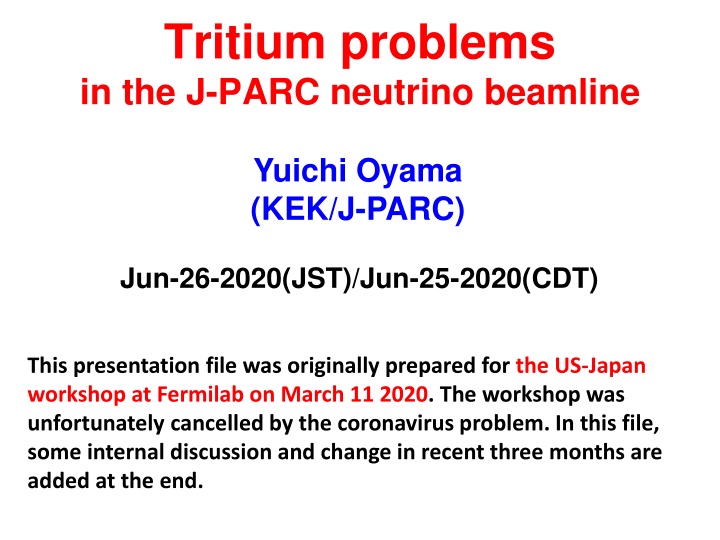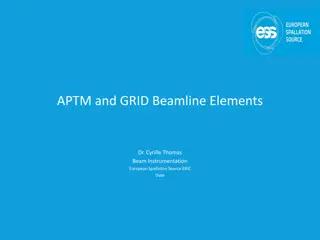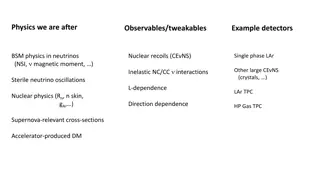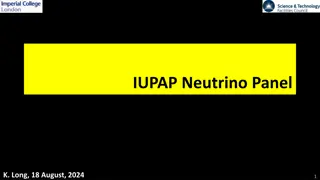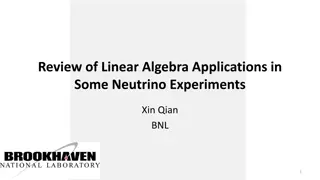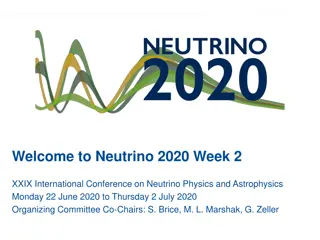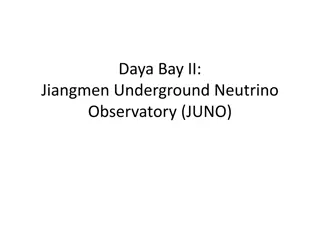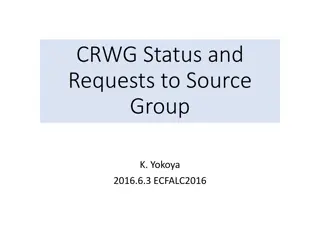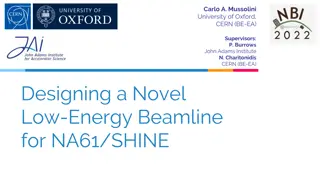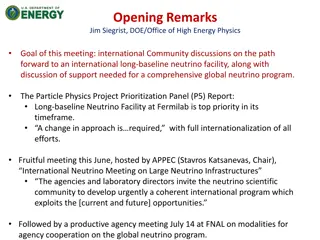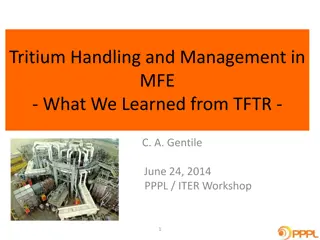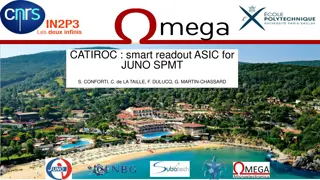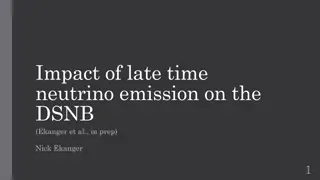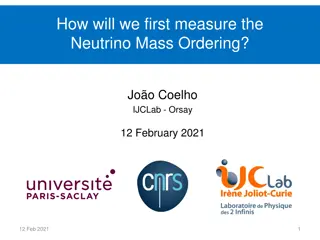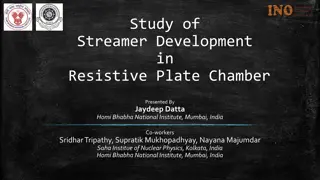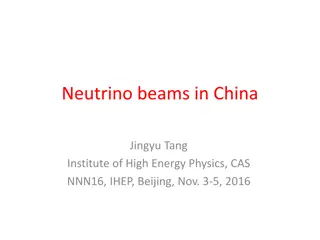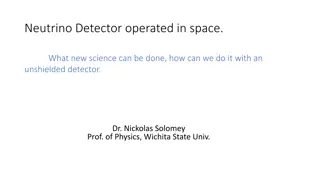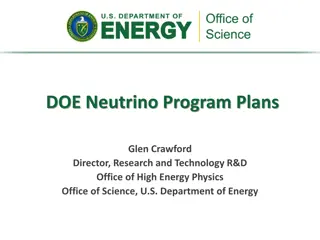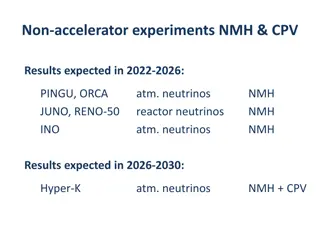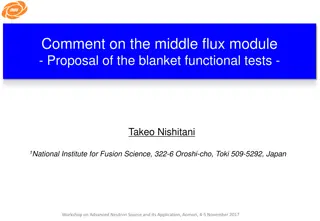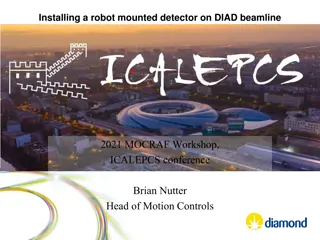Tritium Problems in J-PARC Neutrino Beamline - Recent Developments and Future Implications
This file discusses the issues related to tritium production in the J-PARC neutrino beamline, particularly focusing on the tritium release from steel walls to cooling water and air. It highlights the concerns regarding potential serious problems in the future and the measures undertaken to address the tritium-related challenges. The collaboration with experts from the University of Toyama and the valuable suggestions received are also emphasized, shedding light on the broader implications of tritium issues in high-power beam facilities.
Download Presentation

Please find below an Image/Link to download the presentation.
The content on the website is provided AS IS for your information and personal use only. It may not be sold, licensed, or shared on other websites without obtaining consent from the author.If you encounter any issues during the download, it is possible that the publisher has removed the file from their server.
You are allowed to download the files provided on this website for personal or commercial use, subject to the condition that they are used lawfully. All files are the property of their respective owners.
The content on the website is provided AS IS for your information and personal use only. It may not be sold, licensed, or shared on other websites without obtaining consent from the author.
E N D
Presentation Transcript
Tritium problems in the J-PARC neutrino beamline Yuichi Oyama (KEK/J-PARC) Jun-26-2020(JST)/Jun-25-2020(CDT) This presentation file was originally prepared for the US-Japan workshop at Fermilab on March 11 2020. The workshop was unfortunately cancelled by the coronavirus problem. In this file, some internal discussion and change in recent three months are added at the end.
A new 3H problem summary of my talk in NBI2019 NuMI experience says majority of the tritium produced in the steel shielding can come out, when shielding gets hot at high beam power . (by Prof. Jim Hylen) J-PARC neutrino beamline also has similar 3H from steel wall problems. 3H from steel wall to water 3H concentration in the cooling water continuously increased by ~25Bq/cc per day even after the beam stop. We suspect that 0.20GBq/day of 3H come out from the steel wall to cooling water. 3H from steel wall to air After the beam in 2017, dry air was supplied to helium vessel to exhaust 3H rich air for the maintenance work. However, 3H concentration of the air in the Helium vessel did not reduced below 0.5Bq/cc. This saturation can be explained by 0.72GBq/day of 3H from the steel wall to the dry air.
A new 3H problem summary of my talk in NBI2019 At present, contributions from 3H coming from steel wall is small. However, it might be extremely serious problems in the near future (2030s). 3H comes from steel wall to cooling water may become more than that generated from cooling water. For safety maintenance works in helium vessel, air-line masks to supply fresh air will be needed for workers. 3H coming from steel wall to cooling water were reduced after 1 year. -25Bq/cc/day in September 2018 -12Bq/cc/day in August 2019 Effective half life time is ~1 year. For more details, please visit my presentation file in NBI2019. http://www-nu.kek.jp/~oyama/nbi2019.oyama.ppt https://indico.fnal.gov/event/21143/session/9/contribution/37/material/slides/0.ppt
Progress after NBI2019 In NBI2019, we learned that not only neutrino beamline, but also other high power beam facilities have 3H from materials problem. Especially, the muon beamline in J-PARC MLF has similar problem in their target as reported by Kawamura-san. https://indico.fnal.gov/event/21143/session/9/contribution/38/material/slides/0.pptx Kawamura-san and his colleague collaborate with experts of 3H in University of Toyama for advice and 3H measurements. Hydrogen Isotope Research Center, University of Toyama http://www.hrc.u-toyama.ac.jp/en/ 6 researchers in total, and 3 researchers among them are 3H experts. 25 students (master course of graduate, and undergraduate) . The collaboration was extended to entire J-PARC facilities, and the neutrino group also learned suggestions from them. My presentation from here are partially based on suggestions from them.
Suggestions from 3H experts If you can confine 3H in the steel for a reasonably long time, do confine. Otherwise, release as early as possible. If the time scale of the release is > 10 years, we are very happy. Ten years is a nominal time scale of the entire experiment and the half life of tritium ( 1/2=12.3years). Definitely we should confine 3H. If the time scale of the release is < 1 month, we are happy. 3H can be released in a couple of months, and we can start the maintenance works afterward. Unfortunately, we are just in between! The half lifetime of the 3H release is about 1 year!! Can we change the time scale of the 3H release? When we discuss the time of 3H release from a metal, we must evaluate 2 parameters, diffusivity and solubility. A compilation of tritium Material interaction parameters in fusion reactor materials F. Reiter, K.S. Forcey, G. Gervasini (1993) https://op.europa.eu/en/publication-detail/-/publication/60f147a2-fdc8-49c8-8a87-7af6f09b0a61/language-en
Tritium Diffusivities in materials Diffusivity (D) is a parameter which indicates how fast 3H move in the metal. From Reiter et al. (1993) The diffusion distance of 3H in a metal in time duration t sec can be written as L = (Dt)1/2meter. At room temperature, the 3H diffusivity in iron is D ~ 2 x 10-9m2/s. The 3H diffusivity in iron is larger than that in most of other metals. 3H can travel fast in iron.
Diffusivity The average travel distance of 3H in iron in one month is calculated to be L = (2x10-9x 60 x60 x 24 x 30)1/2= 0.07m = 7cm. On the other hand, nominal thickness of the steel wall of Helium vessel is 10cm. The nominal time scale that 3H reach to the surface of the iron surface is estimated to ~1 month. On the other hand, the half lifetime of the 3H release is ~ 1 year. This discrepancy might be explained if the 3H can reach to the iron surface, but it cannot be released to outside.
Tritium Solubilities in materials Solubility means capacity to hold tritium in the metal . If the solubility is large, it can hold much tritium in the metal. If the solubility of the metal which contact to outside water/vapor is large, it provide larger opportunity for 3H <->1H exchange with outside water/vapor. From Reiter et al. (1993)
Solubility The steel wall can be coated with another metal. 3H release strongly depends on the solubility of the surface metal. If metal of high solubility is used for coating, it can attract3H from the inside steel because of the 3H concentration gradient. Recommendation from the 3H expert To enhance the 3H release, coated with Pd (Palladium) is the best. To suppress the 3H release, coated with Al (Aluminum) is the best. For the enhancement, Pd might be only candidate. The solubilities of Ti (Titanium) and Zr (Zirconium) are also large, but their corrosion resistances are poor and cannot be used for coating. One serious problem is that Pd is expensive. A nominal price of Pd is about 1.5 times of the price of gold. For the suppression, other possible candidates are Sn (Tin) and Zn (Zinc).
What measurement should we do? Prepare metal-coated iron blocks together with other control samples. -Iron block coated with Pd -Iron block coated with Al -Iron block coated with Sn, Zn, .......? -Bare iron block -Iron block coated with mill scale (black skin) Since the thickness of the helium vessel is 10 cm, we prefer 10cm x 10cm x 10cm iron blocks, for example. bare iron mill scale Pd Al Expose the samples to neutron flux for certain time period.
What measurement should we do? After neutron irradiation, the samples are soaked in water. The water is occasionally collected, and 3H concentration is measured by the conventional liquid scintillation method. We are very happy if we can obtain this kind of distribution. Note This is not data but an optimistic guess. There are still some open questions. -So far, there are no quantitative discussion at all. -Total irradiation needed must be evaluated. -Safe remote handling after irradiation must be considered -The method of the coating. sputter deposition" and "electron beam evaporation are possible candidate .
Who, When and Where Honestly speaking, J-PARC neutrino beamline group have mild interest. Although the measurements will be very important for the future beamline design, we cannot incorporate it into J-PARC. If LBNF group has strong interest, we can work together. The measurements must be in time for the final design of the LBNF beamline. It is a strong constraint on the time of the measurement. J-PARC neutrino beamline schedule ..
After March 2020.. The next T2K beam period is fixed to early 2021. We will not open the helium vessel before the beam. We cannot install iron blocks in the helium vessel. Next-next beam period will be in 2022. The iron blocks can be exposed in the 2022 beam, and the result of the test will be obtained around end of 2022 at earliest. Probably it will be too late to be incorporated into the LBNF design. Should we give up to use the J-PARC neutrino beam line?
Q & A and Comment Q) The iron cubes of 10cm x 10cm x 10cm are too heavy for remote handling. A) Yes, I agree. For example 5cm x 5cm x 5cm will be better. Q) Coated with Pd is scientifically interesting. However, Pd is very expensive and use of Pd in the beam line is not realistic. A) Pd can be used only for close access area by workers to save money. All surface of iron wall are not needed to be coated with Pd. C) In T2K, we can wait more that 1 month before the maintenance because the beam time is shared with hadron experiments and the shutdown period is relatively longer. However, the maintenance periods of NuMI and LBNF are short and they hope to start maintenance within one week from the beam stop. Accordingly, enhancement of the 3H release is not realistic in NuMI and LBNF.
Q & A and Comment C) The diffusivity in the discussion is that for pure iron. Since SS400 is used for the steel wall in T2K, the diffusivity is smaller. Also radiation damage will reduce the diffusivity. The reduction of diffusivity will contribute to confinement of 3H in the steel. C) We cannot install the iron blocks inside of the helium vessel because of the time schedule for 2021 beam. However, there are many places for neutron irradiation in J-PARC. Possible candidates are near the MLF target or near the beam window of the neutrino beam line. Quantitative calculation of the neutron fluxes and productions of 3H are needed. C) Sputter deposition" and "electron beam evaporation are good methods for the coating for small portion of metals. However, other methods must be considered for the real beam lines.
